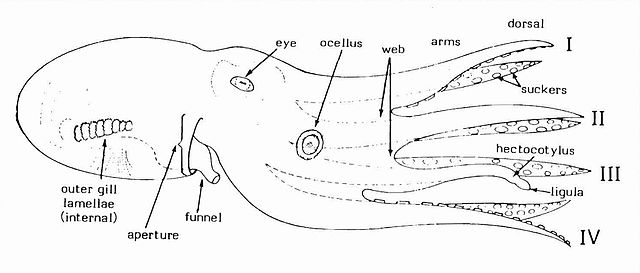The argonauts are a group of pelagic octopuses. They are also called paper nautili, referring to the paper-thin eggcase that females secrete; however, as octopuses, they are only very distant relatives of true nautili. Their structure lacks the gas-filled chambers present in chambered nautilus shells and is not a true cephalopod shell, but rather an evolutionary innovation unique to the genus. It is used as a brood chamber, and to trap surface air to maintain buoyancy. It was once speculated that argonauts did not manufacture their eggcases but utilized shells abandoned by other organisms, in the manner of hermit crabs. Experiments by pioneering marine biologist Jeanne Villepreux-Power in the early 19th century disproved this hypothesis, as Villepreux-Power successfully reared argonaut young and observed their shells' development.
Argonaut (animal)
Mature female A. nodosa
Juvenile female A. hians
Immature male A. hians
An octopus is a soft-bodied, eight-limbed mollusc of the order Octopoda. The order consists of some 300 species and is grouped within the class Cephalopoda with squids, cuttlefish, and nautiloids. Like other cephalopods, an octopus is bilaterally symmetric with two eyes and a beaked mouth at the center point of the eight limbs. The soft body can radically alter its shape, enabling octopuses to squeeze through small gaps. They trail their eight appendages behind them as they swim. The siphon is used both for respiration and for locomotion, by expelling a jet of water. Octopuses have a complex nervous system and excellent sight, and are among the most intelligent and behaviourally diverse of all invertebrates.
Octopus
A giant Pacific octopus at Echizen Matsushima Aquarium, Japan
Diagram of octopus from side, with gills, funnel, eye, ocellus (eyespot), web, arms, suckers, hectocotylus and ligula labelled.
A finned Grimpoteuthis species with its atypical octopus body plan








